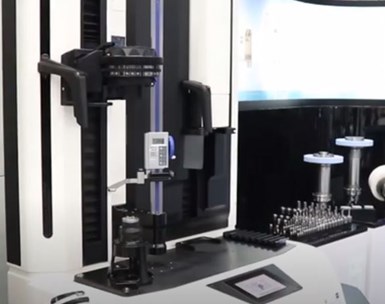A Commitment to Reducing Machining Times
Steven Baier, Haimer USA’s vice president of Sales, shares the company’s four core competencies, its commitment to reducing machining times and why thinking like a manufacturer has proven beneficial.

PMPA: What is a brief history of Haimer?
Steven Baier: Franz Haimer founded Haimer in 1977 in his father’s garage. For our first 11 years, we were a job shop doing work for the aerospace, die mold and defense industries in Germany. Mr. Haimer’s first employee was a local woman named Claudia. Later she became Claudia Haimer. Today, Franz and Claudia Haimer are co-CEOs and Haimer is still a family-owned company.
PMPA: What does Haimer do and who do you serve?
SB: Haimer has four core competencies, Shrink Fit Technology, Balancing Technology, Presetting Technology and Cutting Tool/Tool Holder Technology. All of Haimer’s core competencies are designed to pay for themselves through increasing metal removal rates and reducing machining times. We are so committed to reducing machining times, that we invest 8-10% of all revenue into research and development.
Haimer is strong in the Aerospace, Defense, Semiconductor, Medical, Die Mold and automotive industries. This is because Haimer’s solutions provide our customers with consistent setups that can be measured and improved upon.
PMPA: How are Haimer’s core competencies reflected in the products?
SB: Haimer Shrink Fit Machines and Shrink Fit Holders consistently provide the best gripping torque and runout accuracy of any other tool holding system. Haimer Shrink Fit Holders consistently maintain 0.0001” runout at three times diameter of the cutting tool. Haimer is also the only tool holder manufacturer in the world that also produces a balancing machine specifically for balancing tool holder assemblies. Unbalanced tool holder assemblies create centrifugal forces during rotation that generates vibration. This vibration can only go two places, up into your spindle or down into your part through the cutting tool. Unbalance reduces the life of the machine spindle and cutting tool. Unbalance also affects surface finish negatively. The result is the machinist must slow the machine tool down to make a good part. By running balanced tool holder assemblies, the machinist can increase metal removal rates and reduce machining time. The result is more profit made per part. We also produce presetters so that tools can be preset outside of the machines — while the machines are running — which reduces downtime and eliminates scrapped parts due to tools with excessive runout or other geometrical problems.
Cutting tool technology includes Safe-Lock, Duo-Lock, Haimer Mill and Power Haimer Mill. In addition to sales, we are a manufacturer and, because Mr. Haimer has the mentality of a manufacturer, it is very important that our customers are not locked into just one supplier. Because of this, many of Haimer’s innovations are available from several sources. For example, Haimer’s patented Safe-Lock system is available from over 15 of the world’s leading cutting tool manufacturers.
PMPA: You mentioned Duo-Lock. What is that?
SB: Duo-Lock is the strongest solid carbide indexable end mill system in the world. For example, Duo-Lock end mills are capable of doing a 1.5 times diameter full slot in 4140 steel. Haimer controls the overall length of Duo-Lock end mills to ±0.00039”, which makes very quick tool changes possible. Because Duo-Lock is a threaded on connection it also provides excellent tool security.
PMPA: How do your ER Collets help with machining times?
SB: Duo-Lock ER collets and Shrink Fit ER collets are not the typical collet. Today’s lathe OEMs talk about the horsepower and torque their turrets and spindles have, but operators cannot always take advantage of it. With Duo-Lock ER collets and end mills, an operator can change an end mill in 30 seconds versus three to 15 minutes — less downtime.
The Shrink Fit collets are shaped like a traditional ER collet except they have a precision ground ID that expands like a Shrink Holder to precisely grip a cutting tool. Shrink Collets are heated on a Haimer Shrink Machine like a shrink fit tool holder. When the collet is heated, the gripping ID expands and a cutting tool is inserted. Haimer ER Shrink Collets provide exceptional gripping torque. We have an online video that shows the tool change times — bit.ly/PMPA-PM0720
PMPA: Why do you value your PMPA membership?
SB: The PMPA is a special, tight-knit group of manufacturers and tech suppliers that works together with each other’s best interests in mind. This collaboration results in the old saying that a rising tide lifts all boats. Haimer is proud to be a part of such a great organization.
Related Content
Cold-Drawn Steel Barstock: How It Is Manufactured, Benefits to Your Shop
Understanding the benefits provided by cold-drawn steel barstock can help you optimize the work you quote by maximizing benefits to your manufacturing process and customer.
Read More‘Can You Hold This Tolerance?’ Is Not An Engineering Question
The implications of tolerances go far beyond mere technical compliance.
Read MoreTurned and Polished Steel Barstock: How It Is Manufactured, How It Impacts Your Shop
Understanding the benefits provided by turned and polished steel barstock and its differences from cold-drawn steel barstock can help you and your team avoid unexpected performance issues.
Read MoreOnshoring Weather Report: Strong Tailwinds!
Onshoring, reshoring, nearshoring: these terms are showing up with increasing frequency in the news and online. But is there evidence that these are real?
Read MoreRead Next
Seeing Automated Workpiece Measurement in Real Time
User-friendly inspection software for CNC machining centers was shown at IMTS 2024 monitoring measurements between and after machining while performing SPC based on recorded measurement values.
Read MoreDo You Have Single Points of Failure?
Plans need to be in place before a catastrophic event occurs.
Read MoreA Tooling Workshop Worth a Visit
Marubeni Citizen-Cincom’s tooling and accessory workshop offers a chance to learn more about ancillary devices that can boost machining efficiency and capability.
Read More





















